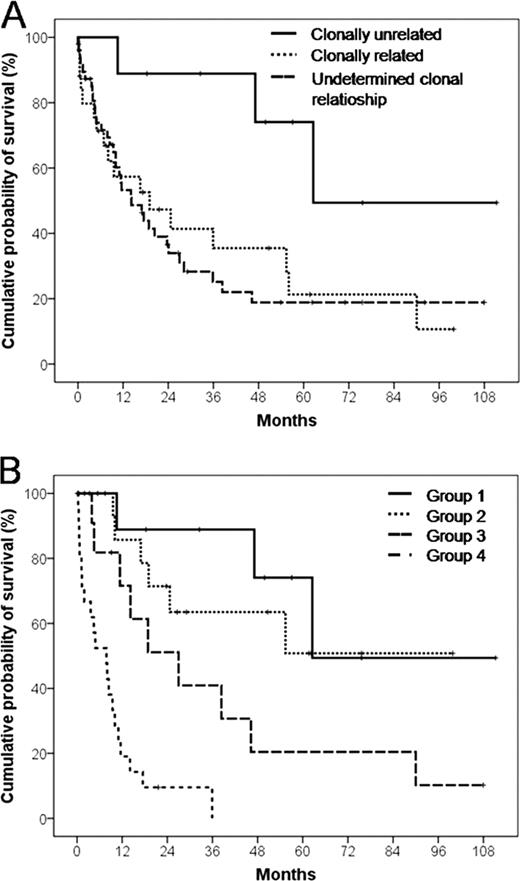Abstract
Abstract 3601
Richter syndrome (RS) represents the development of diffuse large B-cell lymphoma (DLBCL) in the context of chronic lymphocytic leukemia (CLL). Despite the availability of clinical predictors, the identification of RS patients projected to experience long survival represents an unresolved issue that may benefit from the development of novel RS prognosticators. The study was based on 86 RS classified as DLBCL after pathological review. Clonal relationship between CLL/RS pairs was assessed by immunoglobulin gene analysis. RS was clonally related to the CLL phase in 49/59 (83.1%) cases, and clonally unrelated in 10/59 (16.9%). In 27 cases, clonal relationship remained undetermined because of unavailability of paired CLL samples. Out of the molecular features investigated, the prevalence of TP53 disruption by mutations and/or deletion was significantly higher in clonally related RS (23/36, 63.9%) compared to clonally unrelated cases (1/8, 12.5%) (p=.015). Among immunogenetic features, usage of stereotyped VH CDR3 occurred in 25/49 (51.0%) clonally related RS, while was very rare among clonally unrelated cases (1/10, 10.0%) (p=.032). The difference in stereotyped VH CDR3 frequency occurred irrespective of IGHV gene mutation status. All clonally unrelated RS tested negative for EBV infection and none received alemtuzumab before DLBCL development. Clonally related and clonally unrelated RS were indistinguishable in terms of clinical features at presentation. However, RS survival was significantly shorter in clonally related (median: 14.2 months) versus clonally unrelated cases (median: 62.5 months) (p=.017) (Fig. 1A). This survival difference was observed even though clonally related RS received SCT in 8/48 (16.7%) cases, while clonally unrelated RS received in all cases conventional chemotherapy without SCT consolidation. Other variables that were associated with poor RS survival were TP53 disruption (p<.001), age >60 years (p=.005), ECOG PS >1 (p<.001), tumor size >5 cm (p=.001), platelets <100 × 109/l (p=.007), LDH >1.5 ULN (p=.002), and having received SCT (p=.027). None of the pathologic features of DLBCL diagnostic biopsies correlated with RS prognosis. After adjusting for clinical variables associated with RS survival, diagnosis of clonally unrelated RS translated into a 80% reduction in risk of death when compared to clonally related RS (HR: 0.22; p=.036). By recursive-partitioning analysis, clonal relationship, TP53 disruption and ECOG PS were the major determinants of RS survival, and classified RS patients according to risk of death (Fig. 1B). All clonally unrelated RS displayed a low risk of death (median survival 62.5 months; 95% CI: 33.7–91.3), irrespective of TP53 disruption and ECOG PS (Fig. 1B; Group 1). Among clonally related RS and RS with undetermined clonal relationship, patients presenting with ECOG PS ≤1 and no TP53 disruption had a low risk of death (median survival: 55.4 months) (Fig. 1B; Group 2). Patients presenting with ECOG PS ≤1 in the presence of TP53 disruption had an intermediate risk of death (median survival: 27.0 months) (Fig. 1B; Group 3). Patients presenting with ECOG PS >1 had a high risk of death, irrespective of TP53 disruption (median survival: 7.8 months) (Fig. 1B; Group 4). Based on c-statistics, the model including clonal relationship, ECOG PS and TP53 status had a 90% probability of correctly discriminating a priori RS survival (c-statistic=.90±.07). These observations suggest that clonally related and clonally unrelated RS are biologically and clinically distinct disorders, and that clonally unrelated RS should be considered as a secondary DLBCL arising de novo in the context of CLL, rather than a true RS. Therefore, we propose that the diagnosis of RS should be restricted to clonally related cases.
No relevant conflicts of interest to declare.
Author notes
Asterisk with author names denotes non-ASH members.


This feature is available to Subscribers Only
Sign In or Create an Account Close Modal